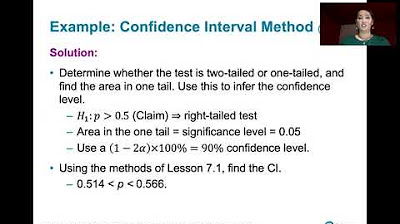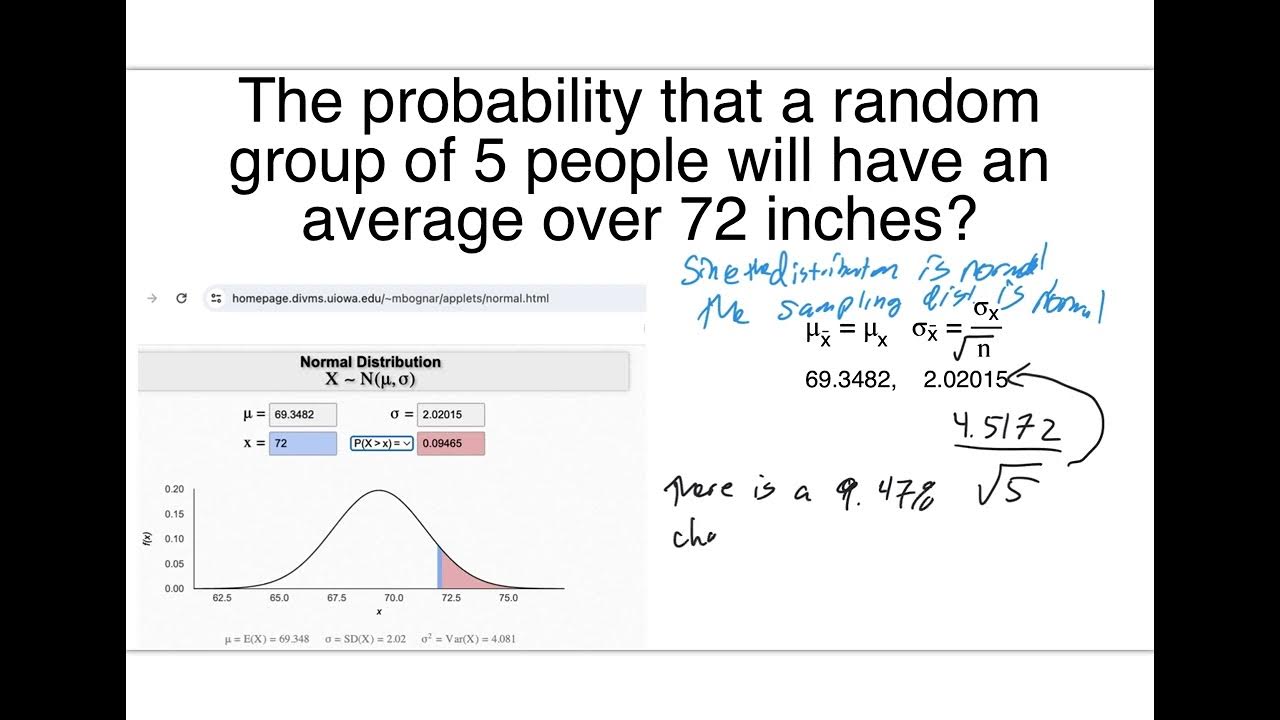Confidence Interval for Mean with Example | Statistics Tutorial #10 | MarinStatsLectures
TLDRThis video script delves into the intricacies of constructing a confidence interval for a population mean, using the example of BMI in Canada. It emphasizes assumptions like simple random sampling and normal distribution, and guides viewers through calculating a 95% confidence interval. The script clarifies the difference between a confidence interval and a probability statement, and touches on hypothesis testing and adjusting confidence levels. The importance of understanding the concepts behind these calculations is highlighted, with the practical application often being done through software.
Takeaways
- 📚 The video discusses the construction of a confidence interval for a population mean, focusing on concepts rather than calculations.
- 🔍 It uses an example of BMI in Canada, comparing the national average to a sample from Vancouver, which is known to be healthier.
- 📉 The sample mean from Vancouver is significantly lower than the national average, with a sample mean of 25.2 compared to 27.2.
- 📊 To construct a confidence interval, certain assumptions must be met: a simple random sample, independent observations, and a large sample size or normal distribution of the population.
- 📉 The importance of avoiding outliers is highlighted, as they can skew the mean and standard deviation.
- 🔢 A 95% confidence interval is calculated using the sample mean plus or minus two times the standard error of the mean.
- 📐 The standard error of the mean is calculated by dividing the sample standard deviation by the square root of the sample size.
- 📈 The video demonstrates the calculation of a 95% confidence interval, which in this case is from 22.7 to 27.7.
- 🔄 The difference between using a rough Z value and the exact T value is discussed, with the video opting for the former to focus on concepts.
- 🔑 The video clarifies that the confidence interval indicates the range in which the population mean is likely to fall, not the range of individual values.
- 🎰 An analogy is used to explain the concept of confidence, comparing it to holding a lottery ticket with a 95% chance of winning, but not knowing the outcome until checked.
- 🔄 The video also discusses constructing a 99% confidence interval, which results in a wider range, and the concept of one-sided confidence intervals for upper or lower bounds.
Q & A
What is the main topic of the video?
-The main topic of the video is constructing a confidence interval for a population mean, using the example of BMI in Canada.
What is the known mean BMI for Canada mentioned in the video?
-The known mean BMI for Canada is 27.2 kilograms per meter squared.
What is the sample mean BMI found in the sample from Vancouver?
-The sample mean BMI found in the sample from Vancouver is 25.2.
What is the sample size used in the Vancouver BMI study?
-The sample size used in the Vancouver BMI study is 16 individuals.
What is the sample standard deviation of the BMI sample from Vancouver?
-The sample standard deviation of the BMI sample from Vancouver is 5.
What are the assumptions needed to construct a confidence interval as discussed in the video?
-The assumptions needed include having a simple random sample, independent observations, a large sample size or approximately normally distributed individuals, and sensitivity to outliers.
What is the rough guideline for a large sample size in constructing a confidence interval?
-The rough guideline for a large sample size is greater than about 20.
What is the difference between a two-sided and a one-sided confidence interval?
-A two-sided confidence interval provides an upper and lower bound for the estimate, while a one-sided confidence interval provides only an upper or lower bound.
What is the purpose of constructing a 99% confidence interval compared to a 95% confidence interval?
-A 99% confidence interval provides a higher level of confidence in the estimate, capturing a wider range of values around the estimate.
How does the video explain the concept of being 95% confident about the population mean being within a certain interval?
-The video uses the analogy of a lottery ticket to explain that being 95% confident means that if we were to repeat the process many times, we expect the true mean to fall within the interval in about 95% of the cases, but it does not imply a probability of the true mean being within the interval in a single instance.
What is the margin of error in the 95% confidence interval calculated in the video?
-The margin of error in the 95% confidence interval is 2.5, based on using a rough Z value of 2.
How does the video suggest controlling the margin of error for a more precise interval?
-The video suggests that controlling the margin of error can be discussed in a separate video, implying that techniques such as increasing the sample size or using more precise statistical methods can be used.
What is the estimated upper bound for the mean BMI of Vancouverites in a 95% one-sided confidence interval?
-The estimated upper bound for the mean BMI of Vancouverites in a 95% one-sided confidence interval is 27.25.
How does the video emphasize the importance of understanding the concepts behind constructing a confidence interval?
-The video emphasizes the importance of understanding the concepts by focusing on the formula and process of constructing a confidence interval, rather than on the exact calculations, which can be done using software.
Outlines
📊 Constructing a Confidence Interval for Population Mean
This paragraph introduces the concept of constructing a confidence interval for a population mean, using the example of BMI in Canada. The mean BMI across Canada is known to be 27.2, and a sample of 16 individuals from Vancouver yields a mean of 25.2 with a standard deviation of 5. The paragraph discusses the assumptions required for constructing a confidence interval, such as having a simple random sample, independent observations, and either a large sample size or a normally distributed population. It also touches on the sensitivity of the confidence interval to outliers and outlines the formula for a 95% two-sided confidence interval, emphasizing the importance of using the exact T value over the rough Z value for more accuracy.
🔍 Understanding Confidence Intervals and Hypothesis Testing
The second paragraph delves deeper into the interpretation of the 95% confidence interval, clarifying that it reflects our confidence that the true population mean falls within the interval, not that there is a 95% chance the population mean is within it. It uses an analogy of a lottery ticket to illustrate the fixed nature of the population mean versus the random nature of the confidence interval. The paragraph also discusses the practicality of using a rough Z value versus the exact T value for constructing confidence intervals and hints at the application of confidence intervals in hypothesis testing, specifically whether the mean BMI for Vancouverites is significantly lower than the Canadian average.
📈 Adjusting Confidence Levels and Margins of Error
The final paragraph explores the construction of a 99% confidence interval to demonstrate the effect of changing the confidence level on the width of the interval. It contrasts the use of Z values with T values and emphasizes the practical insignificance of the difference between them. The paragraph also introduces the concept of one-sided confidence intervals, which provide either an upper or lower bound for the mean, and illustrates how to calculate a 95% upper bound for the mean BMI of Vancouverites. The video script concludes by reinforcing the foundational concepts of confidence intervals and their application to more complex statistical estimates, with a note on the importance of understanding these concepts even as software automates the calculations.
Mindmap
Keywords
💡Confidence Interval
💡Population Mean
💡Sample Mean
💡Sample Standard Deviation
💡Standard Error of the Mean
💡Simple Random Sample
💡Independent Observations
💡Large Sample Size
💡Normal Distribution
💡Outliers
💡Two-Sided Confidence Interval
💡Margin of Error
💡Hypothesis Testing
💡Degrees of Freedom
Highlights
The video discusses constructing a confidence interval for a population mean with a focus on concepts rather than calculations.
An example is provided using the mean BMI across Canada and a sample from Vancouver to illustrate the process.
The importance of having a simple random sample and independent observations for constructing a confidence interval is emphasized.
The assumption of a large sample size or approximately normally distributed individuals is crucial for the confidence interval formula.
Outliers can skew the mean and inflate the standard deviation, impacting the confidence interval.
A 95% two-sided confidence interval for the mean is constructed using a rough value of two standard deviations.
The exact T value is used for more precise intervals, but the rough value is sufficient for conceptual understanding.
The practical difference between using T or Z values is minimal, especially when using software for calculations.
A 99% confidence interval is demonstrated, showing a wider range due to the higher confidence level.
The concept of a one-sided confidence interval is introduced for scenarios where only an upper or lower bound is needed.
The video clarifies the difference between being 95% confident the population mean is within an interval versus there being a 95% chance it is.
An analogy of a lottery ticket is used to explain the fixed nature of the population mean versus the random nature of the confidence interval.
The video discusses how confidence intervals can be used as a preliminary method for hypothesis testing.
The margin of error in a confidence interval can be adjusted to be narrower for more precise estimates.
The foundational concepts of constructing confidence intervals are laid out, applicable to more complex estimates in the future.
The video concludes by emphasizing the importance of understanding the concepts behind confidence intervals rather than just the calculations.
Transcripts
Browse More Related Video

8.2.2 Testing a Claim About A Proportion - Confidence Interval Method, Comparison to Other Methods

9.1.4 Two Proportions - Confidence Intervals for the Difference Between Two Proportions

2610 Chapter 8 Day 1

Confidence Interval Concept Explained | Statistics Tutorial #7 | MarinStatsLectures

Math 14 HW 7.2.5-T Find critical t value, margin of error & confidence interval for population mean.

9.2.4 Two Means, Indep. Samples - Confidence Intervals, St. Deviations Unknown, Not Assumed Equal
5.0 / 5 (0 votes)
Thanks for rating: